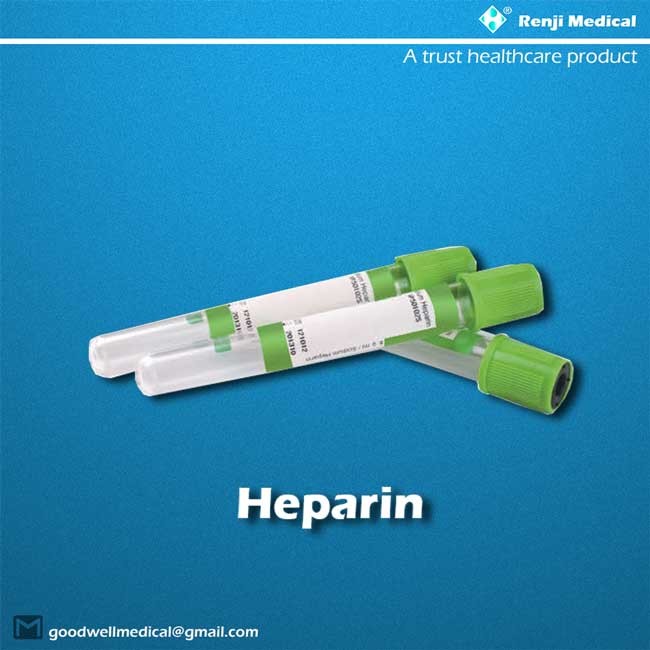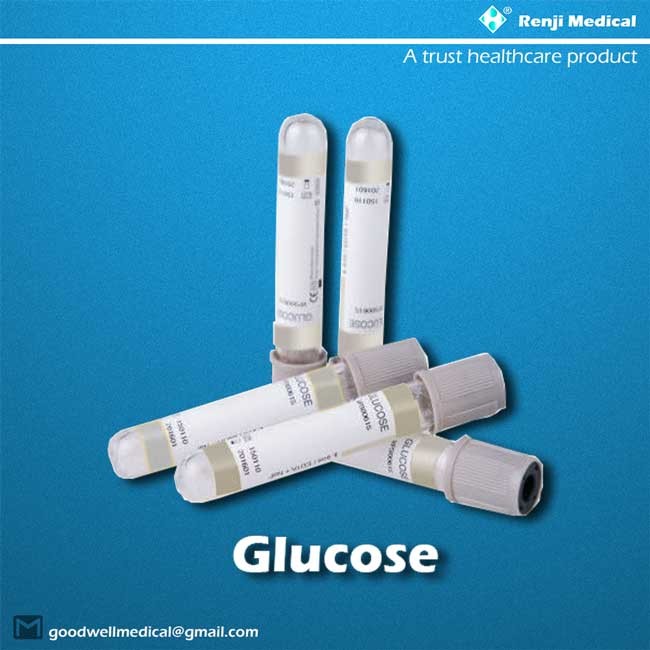Renji Blood Collection Tubes made of PET and color coded based
on the appropriate additive and International Standards
Renji Blood Collection Tubes are made of PET and color coded
according to the
appropriate additive and International Standarts (ISO6710). Each
tube has it own
vacuum state for collection of blood with proper quantity and
marked on label for
blood collection and additives in the tube.
【APPLICATIONS】
Vacuum Blood Collection Tubes are used to transport and process
blood for testing serum,
plasma, or whole blood in the clinical laboratory. According to
different testing, Renji tubes
can be divided into 10 types. That’s Plain Tube, Clot Activator
Tube, Clot Activator& Gel Tube,
Glucose Tube, EDTA&Gel Tube, EDTA tube, Coagulation Tube and
ESR tube, Thrombin-based
Clot Activator&Gel.
Used for collection and storage of blood samples in biochemical,
immune, serum, and other
clinical medical tests. Whether glass tube or plastic tube, its
inner wall is extremely smooth,
can effectively avoid blood cells attached to the wall, minimize
the specimen in vitro
hemolysis.
Our blood collection tubes allow ease-of-use and help to ensure a
quality blood
sample is collected.
Renji Medical offers glass blood collection tubes for a wide range
of laboratory
procedures including hematology, serology, toxicology, blood bank,
routine coagulation
and certain chemistry procedures.Tubes are sterilized by gamma
radiation.
【SIZE AND USES】
Size:(3ml, 5ml, 7ml)
Plain, EDTA, Sodium fluoride, Heparin sodium, Sodium citrate,
Fluoride Oxalate, ESR,
Thrombin, GEL SST.









【PACKING】
100 pieces per tray
【COLLECTION TUBES AND DESCRIPTION】
| Brand/Cap Color/Volume | Additive | Mode of Action |
Uses
|
| BD Red Top (10.0 mL) | Clot activator - plastic None - glass | Blood clots and the serum are separated by centrifugation. | Chemistry, Immunology & Serology, Blood Bank/ crossmatch |
| BD Gold Top (5.0 mL) |
Clot activator and gel for serum separator
| Serum separator tube (SST) contains a gel at the bottom to separate
blood cells from serum on centrifugation. | Chemistry, Immunology and Serology. |
BD Red- Speckled Top (10.0 mL) |
Clot activator and gel for serum separator
| Serum separator tube (SST) contains a gel at the bottom to separate
blood cells from serum on centrifugation. | Serum assays in chemistry |
| BD Purple Top (3.0 mL) | Spray-coated K2 EDTA 5.4 mg (plastic) | Forms calcium salts to remove calcium. | Whole blood analysis in hematology laboratory |
| BD Light Blue Top (2.7 mL) | 0.109M Buff. Sodium Citrate (3.2%) plastic | Forms Calcium salts to remove calcium. | Coagulation Tests |
| BD Green Top (6.0 mL) | Sodium Heparin 95 USP Units or Lithium Heparin | Inactivates thrombin and thromboplastin. | Lithium level – use sodium heparin Ammonia level – use sodium
heparin or lithium heparin |
| BD Light Grey Top (4.0 mL) | Sodium fluoride/ Potassium oxalate 10mg/8mg | Antiglycolytic agent preserves glucose up to five days. |
Glucose (may cause hemolysis if a short draw)
|
| BD Dark Blue Top (6.0 mL) | K2EDTA 10.8 mg | Special stopper formulation offers low levels of trace elements
(see package insert). |
Trace element (zinc, copper, lead, mercury) toxicology and nutrient
determinations
|
| BD Dark Blue Top (6.0 mL) | Clot activator |
| BD Orange Top (5.0 mL) | Rapid Serum Separator (RST) | Quickly clots blood. |
STAT serum chemistries
|
| BD Pink Top (6.0 mL) | Spray-coated K2 EDTA 10.8 mg (plastic) | Forms calcium salts. |
Immunohematology (ABO grouping, Rh typing, Antibody screening) |
Diesse Black Top vacu-tec (1.0mL) | Sodium citrate (buffered) | Forms calcium salts to remove calcium. |
Westergren Sedimentation Rate (ESR)
|
| Vacuette-Greiner Black with yellow insert (5.0 mL) | Serum separator & clot activator | Serum separator tube (SST) contains a gel at the bottom to separate
blood cells from serum on centrifugation. | Lipo profile test only |
| Light Green Top | Lithium Heparin | Plasma separating tube (PST), Blood anticoagulants with lithium
heparin; plasma is separated with PST gel at the bottom of the
tube. | Chemistry |
| Yellow Top | ACD (acid citrate dextrose) | Complement inactivation. | HLA tissue typing, paternity testing, DNA studies |
| Light Brown Top | Sodium heparin | Inactivates thrombin and thromboplastin; contains virtually no
lead. | Serum lead determination |
| White Top | K2 EDTA and gel for plasma separation | Forms calcium salts. |
Molecular/PCR and bDNA testing
|
The most commonly used blood collection tubes
【CHOOSING THE RIGHT BLOOD COLLECTION TUBES】
Whether you’re collecting your samples in-house or through a
clinic, hospital, or pathology
center, you’ll need to have a good idea of what kind of blood
collection tubes suit your purposes.
The first thing to check is your protocol—for example, some ELISAs
will specify the types of
samples you can and can’t use.
But what if your protocol doesn’t specify, or you’re adapting a
method from another system,
or you just want to make sure you’re storing the best type of
sample for future not-yet-defined
analyses? Hopefully, I can help you start to find your way around
all those differently colored
tubes.
A quick note about those cap colors before we begin: I’ve listed
them below, and the
color-coding system is generally pretty consistent, but I can’t
promise the colors are the
same in every company producing blood collection tubes, so always
check first!
Serum Tubes
The first thing to figure out is whether you are after serum, or
whether you’ll need to stop
the blood from clotting.
Don’t get serum confused with plasma—while they’re both the liquid,
cell-free part of the
blood that can be obtained by centrifugation, the key difference is
that serum is the product
of blood that has been allowed to clot, while in a plasma sample,
the dense cells are simply
spun to the bottom.
Serum is, in simple terms, what remains in the blood after it
clots: a cell-free liquid that is
also depleted of coagulation factors. It can be a good, stable way
of measuring the blood’s
proteins, lipids, hormones, electrolytes, and so on. Many of these
markers can be stored
for days in the fridge, or frozen down and measured in batches
later.
- Serum (clot activator) tubes (color dependent on brand: BD is
commonly gold but
also red, Greiner is red). These tubes have silica particles, which
activate clotting.
Some also have a gel to separate the serum. Those without the
separating gel are
potentially more useful in sensitive diagnostic testing. If you’re
looking for a
protein that isn’t involved in coagulation, this is a good place to
start.
- Thrombin-based clot activator tubes (orange). Although the
silica-coated tubes
clot within about 30 minutes, the orange tubes clot within 5
minutes. They’re mainly
used clinically for tests that are needed especially quickly.
However, some of the serum
components are a little less stable in these tubes.
Anticoagulant Tubes
This is the category to consider if you need cells or plasma (a
cell-free liquid that still contains
coagulation factors).
EDTA (Purple)
EDTA prevents clotting by chelating calcium, an essential component
of coagulation. This is
your basic hematology tube (by which I mean identifying and
counting blood cells,
blood typing, etc).
Plasma stored from EDTA-treated blood can also be used to measure
most proteins, and
genetic
material can easily be stored from EDTA buffy coats (the interface between
the red
cells and the plasma after centrifugation, containing white cells
and platelets).
Note: these tubes contain either K2EDTA or K3EDTA.
Sodium Citrate (Light Blue)
For coagulation and platelet function tests. Like EDTA, citrate
acts by removing calcium from
the blood. Unlike EDTA, it’s reversible—so calcium can be added
back to study coagulation
under controlled conditions. Citrated plasma is also used to
measure coagulation-relevant
factors.
It’s worth noting that a citrate tube should not be the first type
of tube filled after
venepuncture—the first few mL of blood drawn will be a bit
activated. If you only need
samples collected in citrate blood collection tubes for your
project, then you should
collect a discard tube first.
Also, note that different concentrations of citrate are available
from different companies.
CTAD (Also Light Blue)
CTAD stands for citrate, theophylline, adenosine, and dipyridamole.
These aren’t very
commonly used but are worth knowing about—they prevent ex vivo activation of your
platelets, making them useful for some more sensitive platelet
function and coagulation
studies. Note that CTAD is light-sensitive, so keep these guys in
the dark.
Lithium/Sodium Heparin (Green)
Similar in use to serum clot activator tubes, but suitable for
tests in plasma rather than
serum. Like the serum tubes, heparin tubes can also come with a
separating gel. Heparin
acts by inhibiting thrombin formation. Note: if your endgame is
PCR, you should know
that heparin is particularly known to interfere with PCR reactions.
However, whichever anticoagulant you choose, you may need to allow
for it in your
reaction mix.
Sodium Fluoride (Color Dependent on Brand: BD is Grey, Greiner is
Black)
Sodium fluoride is an antiglycolytic agent, so these tubes are used
for glucose and lactate
testing. They also contain an anticoagulant (there are different
types available).
Acid Citrate Dextrose—ACD (Yellow)
These ones are not common, but they are used for blood and tissue
typing and DNA analysis.
Sodium Polyanethol Sulfonate—SPS (Also Yellow)
SPS stabilizes bacterial growth. Useful for microbiology.
For more specific purposes, there are more blood collection tubes
out there, but,
hopefully, this has given you a handle on where to start. Good
luck, and welcome to
the world of—let’s be honest—feeling just a little bit like a
vampire.


Step of Correctly Preparing High-Quality Serum with Gel/Clot
Activator Tube

Step1:Place patient's arm in a downward position and clean
venipuncture sire with alcohol;
Step2:Apply tourniquet;
Step3:Remove the upper cover of the needle and assemble the needle
in the holder;
Perform venipuncture with arm downward and tube stopper upper-most;
Step4-5:Push tube onto the needle, puncturing stopper diaphragm;
Step 6; Release tourniquet as soon as blood appears in a tube and
remove the tube from
the holder when the first tube has filed to its stated volume and
blood flow ceases;
Step7:Turn the filed tube upside-down and return it to upright
positions and repeat this
inversion according to different additive performance;
Step8:Place succeeding tubes in the holder, puncturing diaphragm to
begin to follow, see
Recommended Order of Draw;
Step9:As soon as blood stops flowing in the last tube, remove the
tube from the holder
and remove the needle from Vein, applying pressure to puncture site
with the dry sterile
swab until bleeding stops;
Step10:Dispose the needles into Sharps Disposal Containers
according to related policies
and guidelines.
【STORAGE CONDITIONS】
Store at temperature 5 - 25 ℃.
【INDEX OF SYMBOL】

【EXPORTER】
Magnus International Limited
F12, New City International Mansion A, 234 Huapao Ave.
Liuyang, Hunan Province 410300 China
Contact: Goodwellmedical@gmail.com
【AUTHORIZED REPRESENTATIVE】
Lotus NL B.V.
Koningin Julianaplein 10, 1e Verd, 2595AA, The Hague, Netherlands.
【FACTORY VIEW】


【FACTORY WORKSHOP】


【PRODUCTION】

【PRODUCT AND STANDARDS】

【CERTIFICATIONS】


【FAQ】
1. Q: How about your healthcare and medical product quality?
A: Quality is our top priority. We have a professional quality
control team to ensure the
quality with a high standard and regulated with the pro
certifications. The QC team is
responsible for quality checking in each process and inspects every
batch of our production
and ships them only after QC approval.
2. Q: What is your order MOQ?
A: Please contact customer service, and the price is negotiable for
a large quantity.
3. Q: How about your product packing for shipment or mailing?
A: We prepared a well neutral package for our products. We could
also make OEM packages,
OEM/ODM Custom Package/Multi-packing package/Cartons with well
protective wrapping.
4. Q: What level of your product price?
A: We are the factory and direct manufacturer and offer competitive
prices. We also offer
volume pricing with more benefits depending on your order quantity
level. Please let us know
your ordering volume while you make the inquiry to us to help you
obtain better benefits.
5. Q: What're the price terms?
A: The price is based on the FOB of Hunan, China with an exchange
rate of RMB6.40 for
USD$1.00. If the exchange rate floating sharply lower than 6.3 or higher than
6.5, we should
adjust the price with the real-time exchange rate.
6. Q: What're the payment terms?
A: We accept T/T wire transferring, PayPal, Western Union, etc. 50%
down payment after
signing the contract and rest 50% before shipping confirmation.
7. Q: How could I get some samples?
A: We are able to deduct your samples expense once your orders are
confirmed with us.
The shipping fee will be calculated with the sample volume that you
demand.
8. Q: Could you accept OEM orders?
A: Yes, we could. We have professional designers who can design the
logo or artwork and offer
best solution & styles for your OEM product choices.
9. Q: How long will the shipping or express take?
A: (1) For the international express such as DHL, UPS, FedEx, TNT,
or EMS, etc., it usually
takes 5-7 working days to your location or destination.
(2) If shipping with containers, they will take about 30-60 days to
process depending on
the various ports or door locations.
(3) We will arrange the delivery or shipping of your products
within 1-3 days after full
payment has been confirmed. We may not ship your products out until your
payments arrive
to our bank account successfully.
10. Q: How do you deliver the goods to us?
A: If the order of small volume package, we could deliver by
courier such as DHL, UPS, FedEx,
TNT, EMS. For the large volume order, we could ship with bulk cargo
containers by sea.
We will provide you with cost-saving recommendations for your
product shipping.
11. Q: What is the warranty time.
A: One year for each product.
【SHIPPING】
We are the trusted healthcare and medical supplies from China.
Be free to contact us at any time!
You are very welcome to email us today at:
Goodwellmedical@gmail.com for the inquiry!
We are excited to build a reliable and long-term business with you
at our best!


































